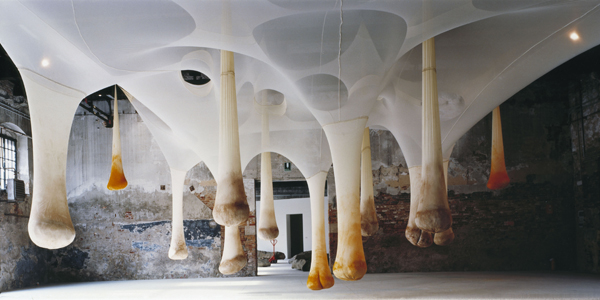« News World
Ernesto Neto at MACRO

Ernesto Neto. E o Bicho, 2001. Installation view 49 Biennale di Venezia, Plateau of human kind, Arsenale. Photo Eduardo Ortega. Courtesy Galeria Fortes Vilaca. SP/ Tanya Bonakdar Gallery, NY
May 30th, 2008 - February 2009
MACRO Hall presents the new site-specific work by the Brazilian artist Ernesto Neto, which comes in the wake of those by Erwin Wurm, Pedro Cabrita Reis and Atelier Van Lieshout.
Making his solo debut in an Italian museum, Ernesto Neto (Rio de Janeiro, 1964) is one of the most significant names in the contemporary art scene. Through his work, the artist brings new life to the very concept of sculpture and architecture, creating spaces, environments and itineraries that involve the public in an all-encompassing perceptive experience.The prime theme of Neto’s sculpture is its effects upon the senses, which is expressed in the sinuous shapes of Lycra, and in the aromas and colours of spices.
The project that Neto has created especially for MACRO Hall is a large installation that takes up the entire area of the Museum’s glazed gallery, forming a sort of floating architecture with organic and floral shapes that invite the visitor to go through and interact with them. The sculpture, which is attached to the gallery’s glass roof trusses, is suspended about one metre from the ground.
The Lycra contains ground spices: pepper, cumin, cloves, ginger and curcuma. The almost anaesthetising aroma of the spices totally envelop our sense of smell, conjuring up familiar or distant flavours and memories, just as the sculptural forms invite us to touch and feel the work with our hands, and listen in silence.
The artist’s aim is to break down the distances between the visitor and the work of art, creating a sort of mystical experience through the discovery of the almost living breathing of these huge creatures with their transparent and harmonious shapes.
Neto’s works form shapes that also break down the barriers between art and life. As he himself states, he creates “an art that unites, helping us interact with others, showing us the limits, not as barriers but as a place of sensations and of exchange and continuity.”
Filed Under: News World


































